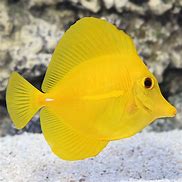1
/
of
1
Hawaiian Yellow Tang
Hawaiian Yellow Tang
The Hawaiian Yellow Tang (Zebrasoma flavescens) is another popular and beautiful fish, commonly seen in home aquariums. Here are some key facts about this stunning fish:
1. Scientific Name:
- Zebrasoma flavescens.
2. Common Names:
- Hawaiian Yellow Tang
- Yellow Tang
- Yellow Surgeonfish
3. Native Habitat:
- The Hawaiian Yellow Tang is native to the Hawaiian Islands, found in the warm waters of the Pacific Ocean. They are commonly found around coral reefs at depths of 3 to 40 meters (10 to 130 feet).
4. Appearance:
- The Hawaiian Yellow Tang has vibrant yellow coloration, which is its most distinctive feature. It has a sleek body with a sharp spine (similar to other surgeonfish), which it uses for defense.
- They have a small, angular body that helps them navigate among rocks and corals in their natural habitat.
5. Size:
- They typically grow to about 8 inches (20 cm) in length but can occasionally reach slightly larger sizes in the wild.
6. Diet:
- Herbivorous: Hawaiian Yellow Tangs feed mainly on algae and other plant matter in the wild, especially algae that grow on the rocks and coral.
- In captivity, they need a diet rich in algae, including nori (seaweed), spirulina, and other green foods to keep them healthy.
7. Lifespan:
- They can live for 10 to 20 years in captivity with proper care and maintenance.
8. Behavior:
- Hawaiian Yellow Tangs are generally peaceful but can be territorial, especially when there are other tangs or similar fish in the tank. However, they are not overly aggressive and can live peacefully with other species in a large enough aquarium.
- They are active swimmers and require plenty of space to move around.
9. Reproductive Behavior:
- In the wild, Yellow Tangs spawn in groups, releasing eggs and sperm into the water column during the full moon. They have external fertilization, and the larvae drift with the ocean currents before settling into reefs.
10. Care in Captivity:
- Hawaiian Yellow Tangs are best suited for intermediate to advanced aquarists due to their size, dietary needs, and space requirements.
- They need a large aquarium (at least 75 gallons or more) with live rock and a good filtration system.
- They thrive in tanks with stable water conditions, including proper salinity, temperature (around 74-80°F or 23-27°C), and pH levels.
11. Health and Disease:
- Like other surgeonfish, they can be prone to marine ich (a parasitic infection) and other diseases if not kept in optimal conditions.
- Regular water changes, a varied diet, and good tank hygiene help prevent illness.
12. Conservation:
- The Hawaiian Yellow Tang is popular in the aquarium trade, and its collection in the wild has raised concerns about overfishing and sustainability. In Hawaii, there have been efforts to regulate the collection and trade of these fish to ensure that populations remain healthy and sustainable.
- In 2020, Hawaii banned the collection of Hawaiian Yellow Tangs for the aquarium trade to protect wild populations and ensure the health of coral reef ecosystems.
13. In Popular Culture:
- The Hawaiian Yellow Tang has been featured in various marine aquarium setups and is often associated with the movie Finding Nemo, where the fish's bright yellow coloration and lively nature make it a fan favorite.
These vibrant, active fish are a great addition to aquariums, provided their space, dietary, and environmental needs are met. They are beautiful to look at, and their cheerful disposition makes them a joy for aquarium hobbyists!
Couldn't load pickup availability


